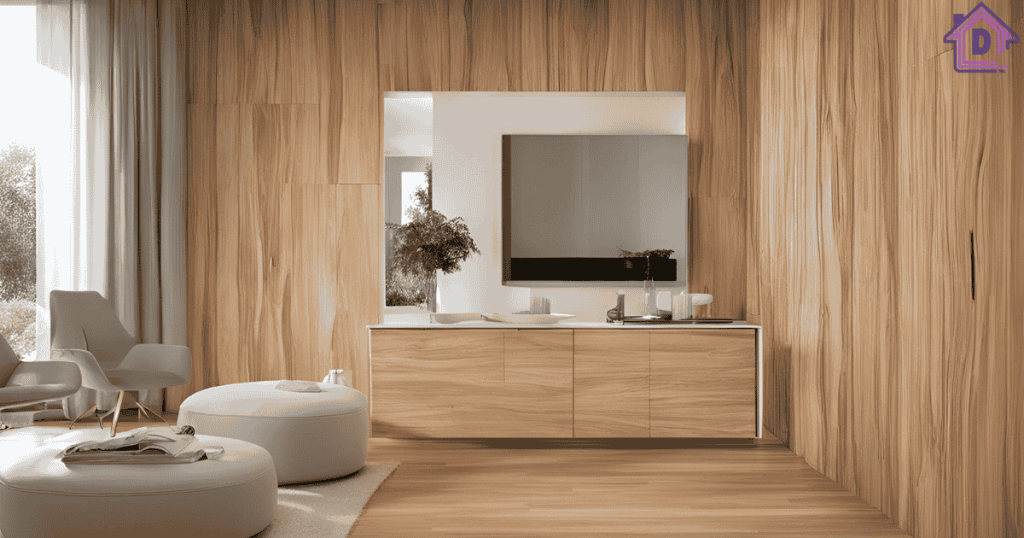Eco-friendly wood veneers are an innovative solution that combines style and sustainability. These veneers offer a practical way to enjoy the beauty of wood while minimizing the environmental impact. When choosing eco-friendly wood veneers, it’s important to understand the process of production, their applications, costs, and how to select the right one for your needs. This article will explore these factors and help you make an informed decision.
What is Wood Veneer?
Wood veneer is a thin layer of real wood applied to a base material like plywood or MDF, offering the appearance of solid wood at a more affordable price. Veneers come in various wood types such as oak, walnut, and cherry, giving you the natural beauty of wood without the high cost.
Why Choose Wood Veneer?
- Cost-Effective: Offers the look of solid wood at a lower price.
- Sustainable: Uses less wood, making it an eco-friendly choice.
- Durable: When finished properly, it’s resistant to scratches and wear.
- Lightweight: Compared to solid wood, it is easier to handle and install.
- Aesthetic Appeal: Showcases beautiful wood grain and texture for a premium look.
1. The Process of Making Eco-Friendly Wood Veneer
Eco-friendly wood veneers are made through a carefully controlled process that emphasizes sustainability. Here is a detailed tutorial on the production of these veneers:
- Harvesting: The process begins with the sustainable harvesting of wood. This involves selecting trees from responsibly managed forests to prevent deforestation and promote biodiversity.
- Slicing: Once the wood is harvested, it is sliced into thin sheets, known as veneers. The slicing technique ensures that the maximum use is made of the available wood, reducing waste.
- Drying: The wood veneers are then dried in a controlled environment to prevent cracking and ensure durability.
- Finishing: Finally, eco-friendly finishes, such as water-based or plant-based coatings, are applied to the veneers. These finishes are less harmful to the environment compared to traditional chemical-based finishes.
Let’s take a look at the chart that shows the demand growth for eco-friendly wood veneers from 2018 to 2023. It reveals a consistent rise in demand, particularly from 2020 onwards, driven by the increasing focus on sustainability and eco-conscious design in residential and commercial spaces.
2. How to Choose the Right Eco-Friendly Veneer
Selecting the right eco-friendly wood veneer depends on several factors. Follow these steps to choose the best option for your project:
- Check Certification: Look for veneers certified by organizations like FSC (Forest Stewardship Council) or PEFC (Programme for the Endorsement of Forest Certification). These certifications ensure that the wood originates from forests that are maintained sustainably.
- Consider the Type of Wood: Different types of wood offer unique aesthetics. Decide if you want a light, medium, or dark veneer and choose the wood species accordingly.
- Think About the Application: Consider where and how you’ll use the veneer. Some are better for high-traffic areas, while others may be suited for decorative projects.
- Check for Low-Emission Finishes: Ensure that the veneer has been treated with low-emission finishes to reduce harmful indoor air pollution.
- Assess the Durability: Choose a veneer that will withstand wear and tear, particularly if it will be used on furniture or flooring.
3. Practical Applications of Eco-Friendly Veneer
Eco-friendly wood veneers are versatile and can be used in a variety of applications. Some of the most popular uses include:

- Furniture: Eco-friendly veneers are ideal for crafting furniture that combines durability and aesthetic appeal, such as desks, tables, and cabinets.
- Wall Panels: Veneers can be applied to walls for a natural, sophisticated look.
- Flooring: Some eco-friendly veneers are durable enough for flooring applications, providing a beautiful and sustainable alternative to hardwood.
- Cabinetry: Veneers are a great choice for kitchen and bathroom cabinetry, offering a stylish and eco-conscious finish.
By using eco-friendly veneers, you can create stunning pieces while supporting sustainable practices.
4. Eco-Friendly Wood Veneer Cost
Eco-friendly wood veneers may cost more than traditional veneers, but the price is often justified by their sustainability. Here’s a breakdown of the factors that influence cost:
- Wood Species: Rare and exotic woods typically cost more, while more common species may be more affordable.
- Thickness: Thicker veneers generally cost more due to the additional processing required.
- Certification: Veneers with certifications such as FSC or PEFC can be more expensive because they adhere to stricter environmental standards.
- Finishing: The type of finish applied to the veneer can also influence the cost. Natural, non-toxic finishes tend to be more expensive but are safer for both the environment and your health.
While eco-friendly wood veneers may have a higher upfront cost, their long-term sustainability makes them a worthwhile investment.
5. Which Wood Is Best for Veneer?
When selecting the best wood for veneers, consider the following:
- Oak: Known for its durability and timeless appeal, oak is a popular choice for veneer.
- Maple: Offers a smooth, clean finish with a light colour, making it a versatile option.
- Cherry: Cherry veneer has a rich, warm colour and is prized for its luxurious appearance.
- Walnut: Walnut is a high-end veneer with a deep, rich colour, often used for premium furniture and cabinetry.
- Bamboo: Bamboo veneers are a great eco-friendly choice due to bamboo’s fast growth and sustainability.
Each wood type brings unique qualities, so the best choice depends on your aesthetic preferences and the application.
6. Which Veneer Is Better?
The “best” veneer depends on your specific needs, but here are a few things to consider:
- For Sustainability: Bamboo veneers and those from FSC-certified sources are some of the most eco-friendly options.
- For Durability: Oak and walnut are some of the most durable and long-lasting veneers.
- For Aesthetic Appeal: Choose cherry or maple for a sophisticated and classic look.
Consider your budget, environmental goals, and design needs when choosing the best veneer for your project.
7. What Is the Most Natural Veneer?
The most natural veneer is typically one that has undergone minimal processing and uses environmentally friendly finishes. Bamboo veneers are among the most natural options available. They are not only renewable but also require fewer chemicals during processing. Other natural options include veneers made from reclaimed wood, which offer a rustic and eco-conscious aesthetic.
8. FAQs and Concerns Related to Eco-Friendly Wood Veneers
1. Are eco-friendly wood veneers as durable as traditional veneers?
Yes, they can be just as durable.
2. Do eco-friendly wood veneers cost more than regular veneers?
Yes, but it’s due to their sustainability.
3. Are there any chemicals in eco-friendly wood veneers?
No, they use non-toxic, low-emission finishes.
4. Can I use eco-friendly wood veneers in high-traffic areas?
Yes, some are durable enough.
5. What makes a veneer eco-friendly?
Sustainable sourcing, minimal chemicals, and non-toxic finishes.
[hurrytimer id=”839″]
Conclusion
Eco-friendly wood veneers offer a sustainable and beautiful option for a variety of applications, from furniture to flooring. By understanding the process of making these veneers, choosing the right one, and considering the cost and benefits, you can make an informed decision. Whether you’re building a new piece of furniture or renovating your home, eco-friendly wood veneers provide a responsible choice without compromising on quality or aesthetics.

